Sequential Injection System for Analysis of Degree Brix, Orthophosphate and pH in Raw Sugarcane Juice Applicable to Sugar Industry
Abstract
:1. Introduction
2. Results and Discussion
2.1. System Design
2.2. ISFET Flow Cell for pH Measurement
2.3. The Schlieren Effect for Brix Analysis
2.4. Compensation of Schlieren Effect for Orthophosphate Analysis
2.5. System Optimization
2.5.1. Sample Volume
2.5.2. Reagent Concentrations for Orthophosphate Analysis
2.6. Interference Study
2.7. Analytical Features and Application
2.8. Comparison with Other Flow-Based Methods for Analysis of Sugarcane Juice
3. Materials and Methods
3.1. Chemicals and Reagents
3.2. Sugarcane Juice Sample
3.3. The SIA System
4. Conclusions
Author Contributions
Funding
Institutional Review Board Statement
Informed Consent Statement
Data Availability Statement
Acknowledgments
Conflicts of Interest
Sample Availability
References
- Hoareau, W.; Hoareau, S.; Petit, A.; Roussel, C.; Corcodel, L. Non-lead polarimetry for sugarcane juice and factory products. Sugar Ind. 2010, 135, 69–81. [Google Scholar] [CrossRef]
- Meade, G.P.; Chen, J.C.P. Cane Sugar Handbook, 10th ed.; John Wiley and Sons: New York, NY, USA, 1977. [Google Scholar]
- Wong-Chong, J.; Martin, F.A. Analysis of sugar cane saccharides by liquid chromatography I. Adsorption chromatography with flow programming. J. Agric. Food. Chem. 1979, 27, 927–929. [Google Scholar] [CrossRef]
- Wong-Chong, J.; Martin, F.A. Analysis of sugar cane saccharides by liquid chromatography. 2. Ion-exchange resins. J. Agric. Food. Chem. 1979, 27, 929–932. [Google Scholar] [CrossRef]
- Cadet, F.; Offmann, B. Direct Spectroscopic Sucrose Determination of Raw Sugar Cane Juices. J. Agric. Food. Chem. 1997, 45, 166–171. [Google Scholar] [CrossRef]
- Melquiades, F.L.; Bortoleto, G.G.; Marchiori, L.F.S.; Bueno, M.I.M.S. Direct Determination of Sugar Cane Quality Parameters by X-ray Spectrometry and Multivariate Analysis. J. Agric. Food. Chem. 2012, 60, 10755–10761. [Google Scholar] [CrossRef] [PubMed] [Green Version]
- Thavarungkul, P.; Suppapitnarm, P.; Kanatharana, P.; Mattiasson, B. Batch injection analysis for the determination of sucrose in sugar cane juice using immobilized invertase and thermometric detection. Biosens. Bioelectron. 1999, 14, 19–25. [Google Scholar] [CrossRef]
- Mattos, I.L.; Zagatto, E.A.G.; Jacintho, A.O. Spectrophotometric flow-injection determination of sucrose and total reducing sugar in sugar-cane juice and molasses. Anal. Chim. Acta 1988, 214, 247–257. [Google Scholar] [CrossRef]
- Zagatto, E.A.G.; Mattos, I.L.; Jacintho, A.O. Determination of sucrose in sugar-cane juice and molasses by flow-injection spectrophotometry. Anal. Chim. Acta 1988, 204, 259–270. [Google Scholar] [CrossRef]
- Oliveira, A.F.; Fatibello-Filho, O. Flow injection spectrophotometric determination of reducing sugars using a focalized coiled reactor in a domestic microwave oven. Talanta 1999, 50, 899–904. [Google Scholar] [CrossRef]
- Sartini, R.P.; Oliveira, C.C.; Zagatto, E.A.G. Bergamin Filho, H.; Determination of reducing sugars by flow injection gravimetry. Anal. Chim. Acta 1998, 366, 119–125. [Google Scholar] [CrossRef]
- Magna, A.; de Oliveira, A.F.; Fatibello-Filho, O. Flow Injection Piezoelectric Determination of Brix in Sugar Cane Juice and in the Alcoholic Fermentation Process. Anal. Lett. 1996, 29, 2411–2419. [Google Scholar] [CrossRef]
- Kronka, E.A.M.; Paim, A.P.S.; Reis, B.F.; Lima, J.L.F.C.; Lapa, R.A. Determination of glucose in soft drink and sugar-cane juice employing a multicommutation approach in flow system and enzymatic reaction. Fresenius J. Anal. Chem. 1999, 364, 358–361. [Google Scholar] [CrossRef]
- Doherty, W.O.S.; Rackemann, D.W. Some aspects of calcium phosphate chemistry in sugarcane clarification. Int. Sugar J. 2009, 111, 448–454. [Google Scholar]
- Brasil, M.A.S.; Sasaki, M.K.; Kamogawa, M.Y. New approach for direct analysis of opaque solutions with high content of suspended solids: Determination of calcium and phosphate in raw sugarcane juice. Talanta 2021, 226, 122095. [Google Scholar] [CrossRef]
- Mahadevaiah; Kumar, M.S.Y.; Galil, M.S.A.; Suresha, M.S.; Sathish, M.A.; Nagendrappa, G. A Simple Spectrophotometric Determination of Phosphate in Sugarcane Juices, Water and Detergent Samples. E-J. Chem. 2007, 4, 576560. [Google Scholar]
- Walford, S.N. Applications of ion chromatography in cane sugar research and process problems. J. Chromatogr. A 2002, 956, 187–199. [Google Scholar] [CrossRef]
- Baikow, V.E. Chapter 7—Liming of Cane Juice. In Sugar Series; Baikow, V.E., Ed.; Elsevier Science Publishing Company Inc.: New York, NY, USA, 1982; Volume 2, pp. 111–117. [Google Scholar]
- Saetear, P.; Khamtau, K.; Ratanawimarnwong, N.; Sereenonchai, K.; Nacapricha, D. Sequential injection system for simultaneous determination of sucrose and phosphate in cola drinks using paired emitter-detector diode sensor. Talanta 2013, 115, 361–366. [Google Scholar] [CrossRef]
- Teerasong, S.; Chan-Eam, S.; Sereenonchai, K.; Amornthammarong, N.; Ratanawimarnwong, N.; Nacapricha, D. A reagent-free SIA module for monitoring of sugar, color and dissolved CO2 content in soft drinks. Anal. Chim. Acta 2010, 668, 47–53. [Google Scholar] [CrossRef]
- Mantim, T.; Saetear, P.; Teerasong, S.; Chan-Eam, S.; Sereenonchai, K.; Amornthammarong, N.; Ratanawimarnwong, N.; Wilairat, P.; Meesiri, W.; Uraisin, K.; et al. Reagent-free analytical flow methods for the soft drink industry: Efforts for environmentally friendly chemical analysis. Pure Appl. Chem. 2012, 84, 2015–2025. [Google Scholar] [CrossRef]
- Dias, A.C.B.; Borges, E.P.; Zagatto, E.A.G.; Worsfold, P.J. A critical examination of the components of the Schlieren effect in flow analysis. Talanta 2006, 68, 1076–1082. [Google Scholar] [CrossRef]
- Betteridge, D.; Dagless, E.L.; Fields, B.; Graves, N.F. A highly sensitive flow-through phototransducer for unsegmented continuous-flow analysis demonstrating high-speed spectrophotometry at the parts per 109 level and a new method of refractometric determinations. Analyst 1978, 103, 897–908. [Google Scholar] [CrossRef]
- Krug, F.J.; Filho, H.B.; Zagatto, E.A.G.; Jørgensen, S.S. Rapid determination of sulphate in natural waters and plant digests by continuous flow injection turbidimetry. Analyst 1977, 102, 503–508. [Google Scholar] [CrossRef]
- Zagatto, E.A.G.; Arruda, M.A.Z.; Jacintho, A.O.; Mattos, I.L. Compensation of the Schlieren effect in flow-injection analysis by using dual-wavelength spectrophotometry. Anal. Chim. Acta 1990, 234, 153–160. [Google Scholar] [CrossRef]
- Fang, Z. Flow Injection Separation and Preconcentration; VCH, Weinheim: Hoboken, NJ, USA, 1993; Volume 41. [Google Scholar]
- Zagatto, E.A.G.; Oliveira, C.C.; Townshend, A.; Worsfold, P.J. Chapter 4—Interaction of Radiation with the Flowing Sample. In Flow Analysis with Spectrophotometric and Luminometric Detection; Zagatto, E.A.G., Oliveira, C.C., Townshend, A., Worsfold, P.J., Eds.; Elsevier: Amsterdam, The Netherland, 2012; pp. 95–146. [Google Scholar]
- Drummond, L.; Maher, W. Determination of phosphorus in aqueous solution via formation of the phosphoantimonylmolybdenum blue complex. Re-examination of optimum conditions for the analysis of phosphate. Anal. Chim. Acta 1995, 302, 69–74. [Google Scholar] [CrossRef]
- Zhang, J.Z.; Fischer, C.J.; Ortner, P.B. Optimization of performance and minimization of silicate interference in continuous flow phosphate analysis. Talanta 1999, 49, 293–304. [Google Scholar] [CrossRef]
- Yaqoob, M.; Nabi, A.; Worsfold, P.J. Determination of nanomolar concentrations of phosphate in freshwaters using flow injection with luminol chemiluminescence detection. Anal. Chim. Acta 2004, 510, 213–218. [Google Scholar] [CrossRef]
- Miller, J.N.; Miller, J.C. Statistics and Chemometrics for Analytical Chemistry, 5th ed.; Pearson Education Limited: London, UK, 2005. [Google Scholar]
- ICUMSA Method GS 7–15 Determination of Total and Soluble Phosphate in Cane Juice by a Colorimetric Method; Verlag Dr. Albert Bartens KG: Berlin, Germany, 1994.
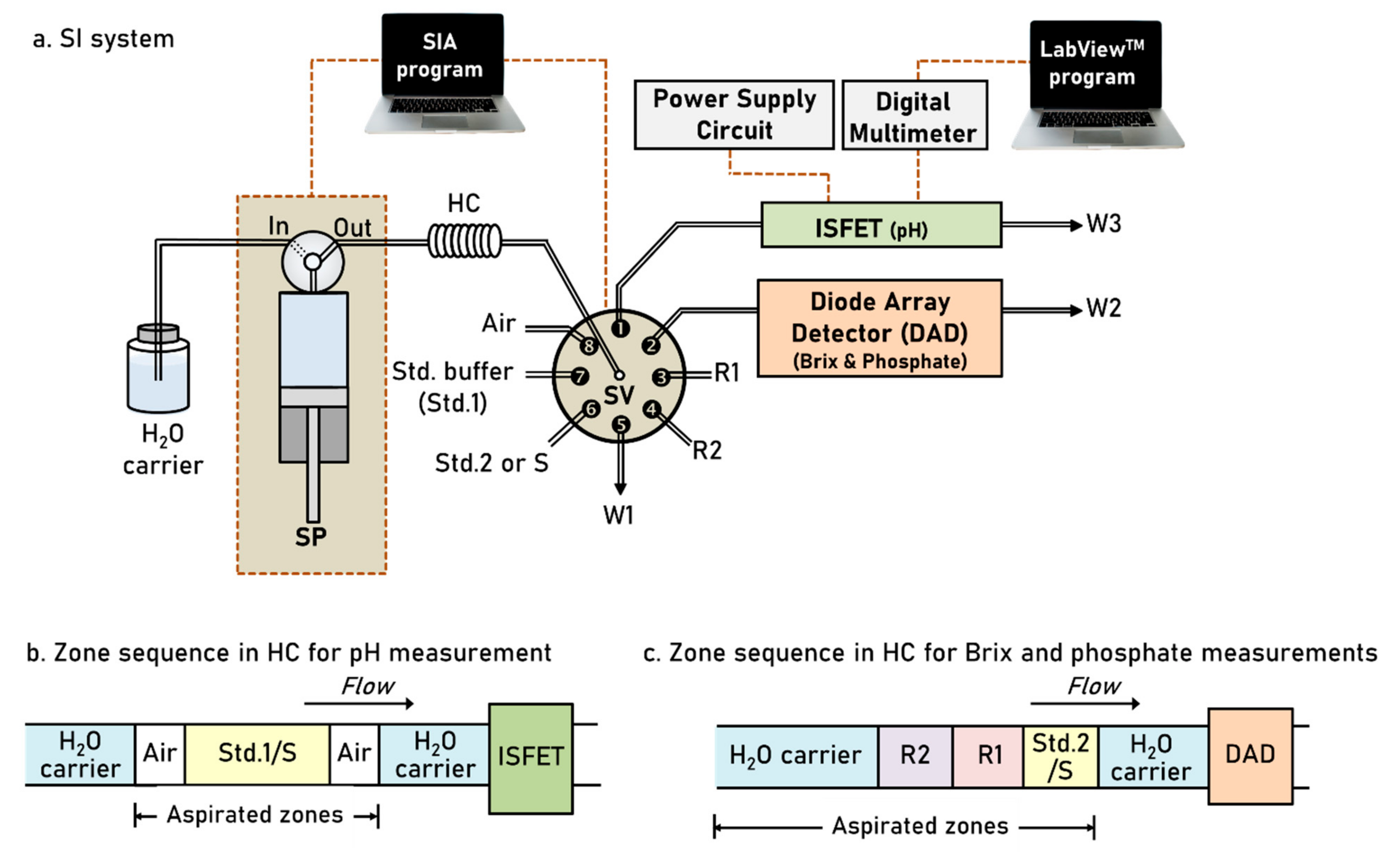
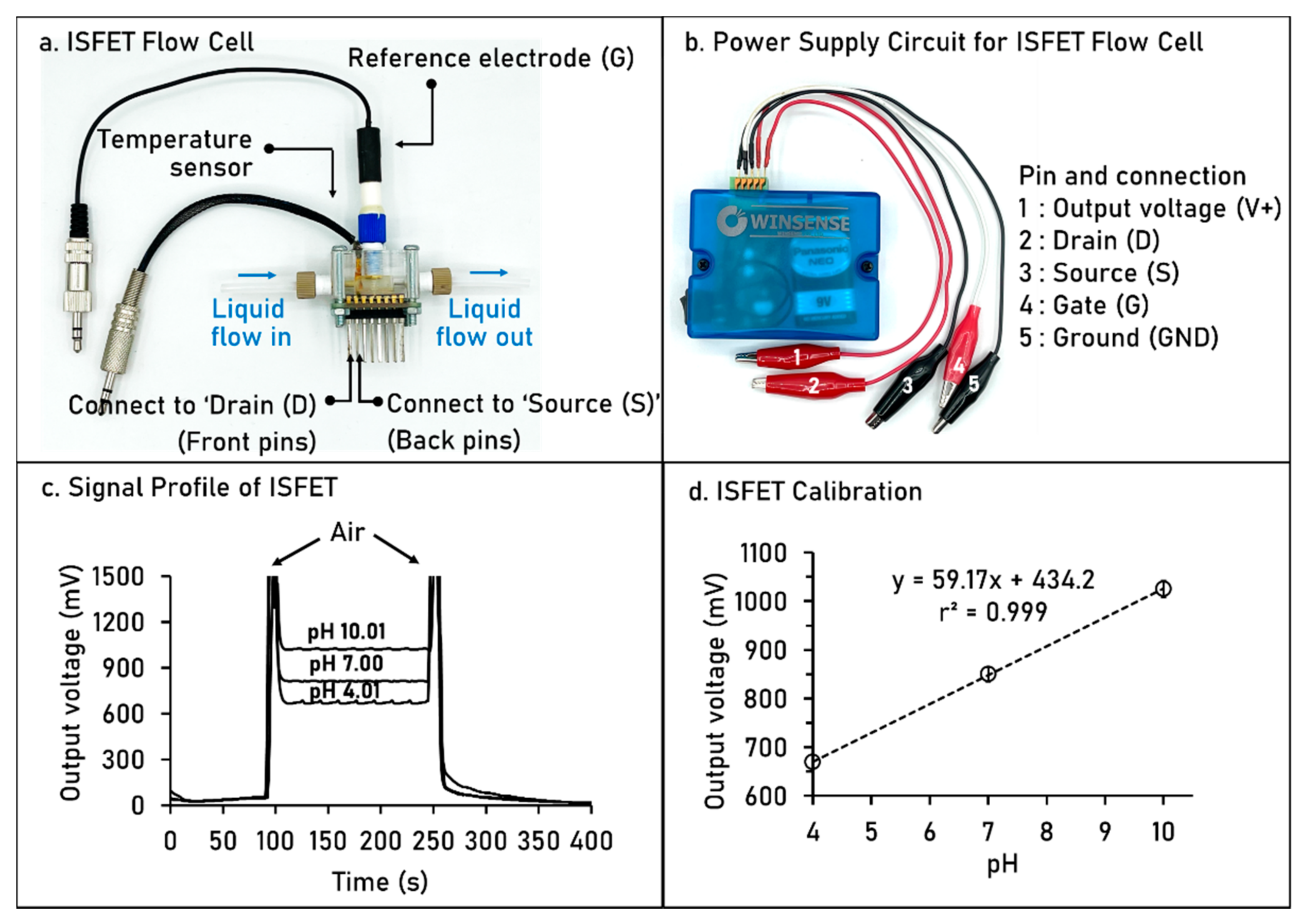
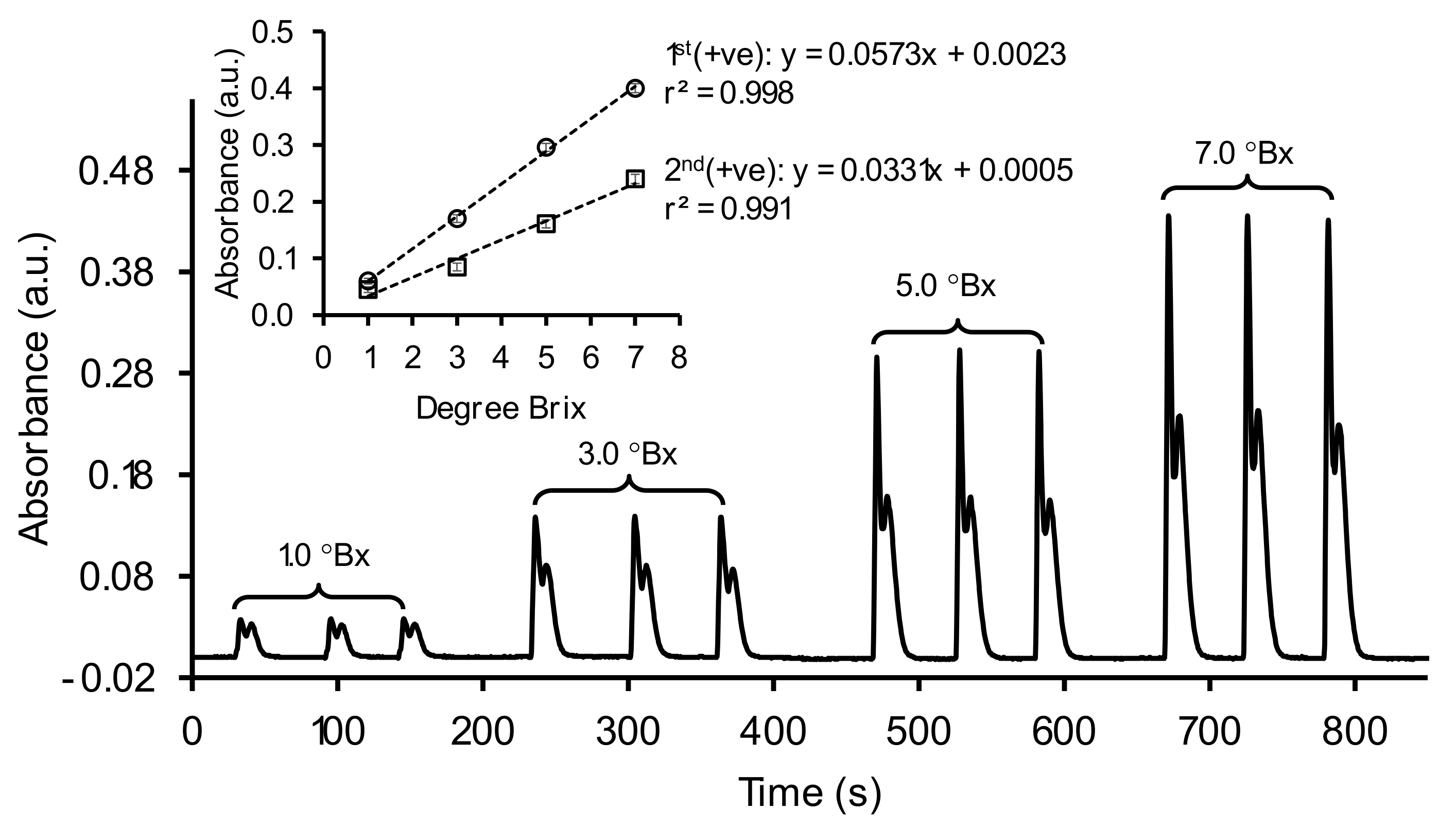
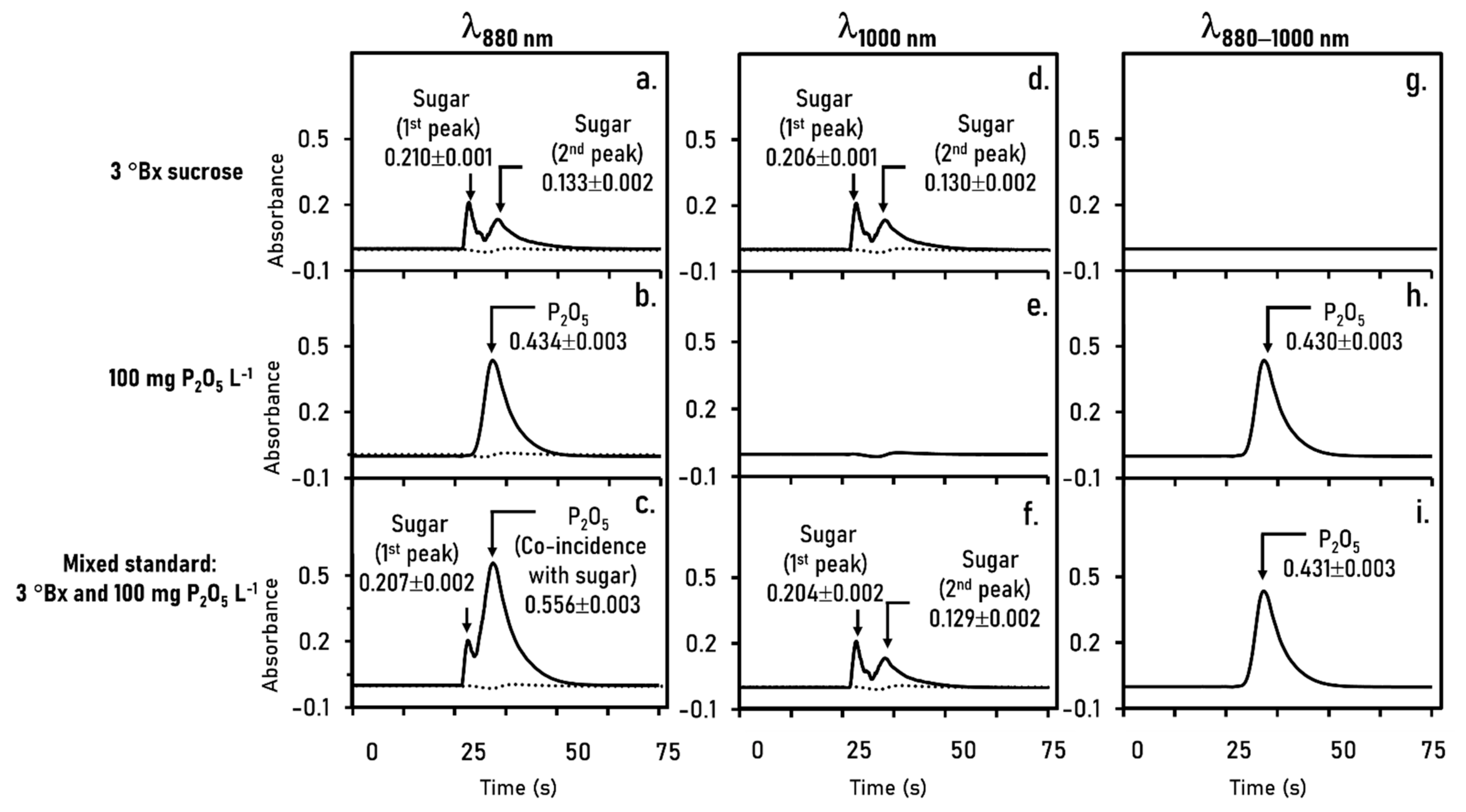
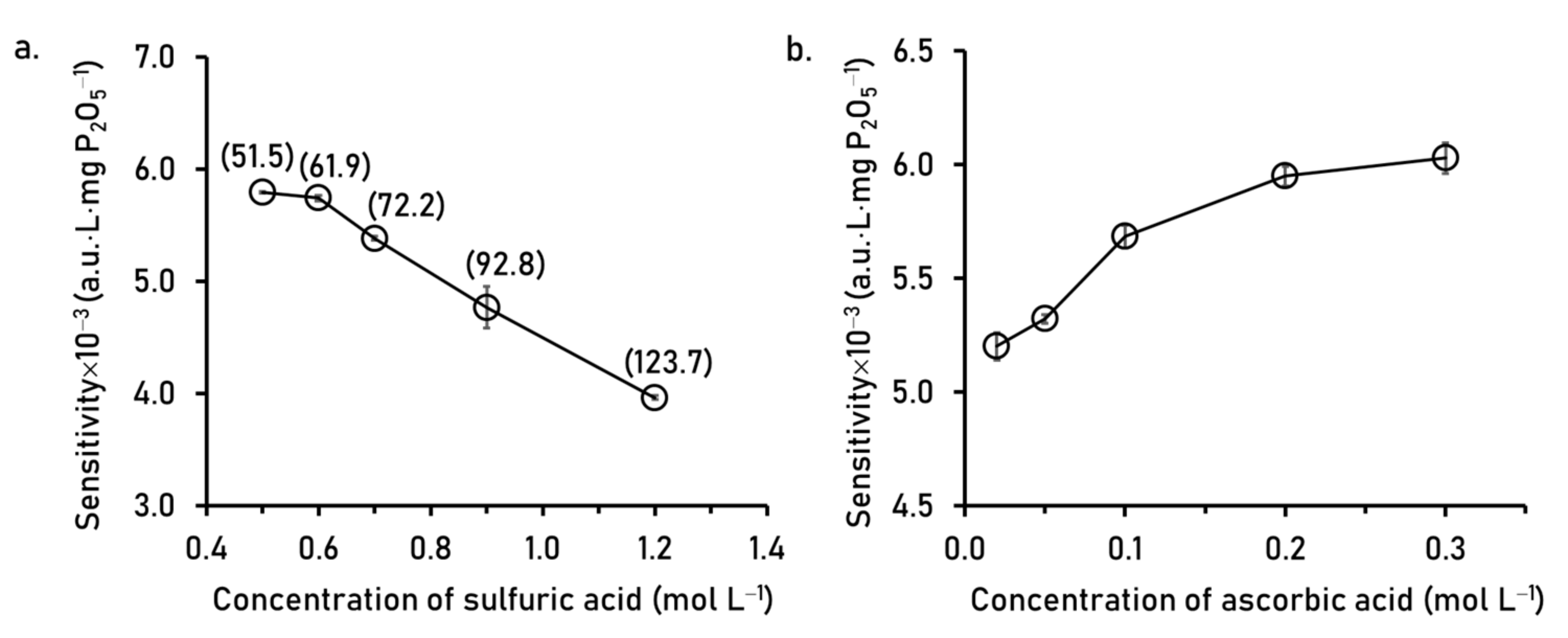

| Step | Syringe Valve Port | Motion of SP | Connection of SV Port | Flow Rate (μL s−1) | Volume (μL) | Description | Period (s) |
|---|---|---|---|---|---|---|---|
| pH Measurement | |||||||
| 1 | Out | Down | HC-SV-P8 | 10 | 25 | Air loaded into HC | 2.5 |
| 2 | Out | Down | HC-SV-P6 | 50 | 1500 | Sample (S) loaded into HC | 30 |
| 3 | Out | Down | HC-SV-P8 | 10 | 25 | Air loaded into HC | 2.5 |
| 4 | Out | Up | HC-SV-P1 | 50 | 1550 | Sample in HC moved toward the ISFET detector and waste (W3) for pH measurement | 31 |
| Clean the Flow Path of HC | |||||||
| 5 | In | Down | - | 100 | 5000 | Water carrier loaded into SP | 50 |
| 6 | Out | Up | HC-SV-P5 | 100 | 5000 | Water carrier dispensed to waste (W1) for cleaning the flow path | 50 |
| Degree Brix and Orthophosphate Measurements | |||||||
| 7 | In | Down | - | 100 | 2500 | Water carrier loaded into SP | 25 |
| 8 | Out | Down | HC-SV-P4 | 20 | 100 | Ascorbic acid solution (R2) loaded into HC | 5 |
| 9 | Out | Down | HC-SV-P3 | 20 | 100 | Acidic molybdate solution (R1) loaded into HC | 5 |
| 10 | Out | Down | HC-SV-P6 | 20 | 50 | Sample (S) loaded into HC | 2.5 |
| 11 | Out | Up | HC-SV-P2 | 100 | 2750 | Solutions in HC transferred to the diode-array detector and waste (W2) for recording of the flow profile | 27.5 |
| Clean the Flow Path to ISFET Detector | |||||||
| 12 | In | Down | - | 100 | 5000 | Water carrier loaded into SP | 50 |
| 13 | Out | Up | HC-SV-P1 | 100 | 5000 | Water carrier in SP moved toward the ISFET detector and waste (W3) | 50 |
| Sample Volume (μL) | Degree Brix | Orthophosphate | ||
|---|---|---|---|---|
| Calibration Equation, r2 | Linearity Range (°Bx) | Calibration Equation, r2 | Linearity Range (mg P2O5 L−1) | |
| 25 | y = (3.35 × 10−2)x + (0.28 × 10−2), r2 = 0.999 | 1.0–7.0 | y = (3.04 × 10−3)x + (3.39 × 10−2), r2 = 0.999 | 20–200 |
| 50 | y = (5.71 × 10−2)x + (0.39 × 10−2), r2 = 0.999 | 1.0–7.0 | y = (5.62 × 10−3)x + (3.36 × 10−2), r2 = 0.999 | 20–200 |
| 75 | y = (8.50 × 10−2)x + (0.31 × 10−2), r2 = 0.995 | 1.0–5.0 | y = (12.3 × 10−3)x + (2.41 × 10−2), r2 = 0.999 | 20–200 |
| 100 | y = (8.41 × 10−2)x + (0.18 × 10−2), r2 = 0.993 | 1.0–5.0 | y = (18.0 × 10−3)x + (4.11 × 10−2), r2 = 0.996 | 20–150 |
| Feature | Performance | ||
|---|---|---|---|
| pH | Degree Brix | Orthophosphate | |
| Working range | 0–14 pH | 1.0–7.0 °Bx sucrose | 20–200 mg P2O5 L−1 |
| Example calibration equation | mV = (59.17 ± 0.48) pH + (434.2 ± 3.6) | Abs1000 nm = [(5.71 ± 0.12) × 10−3] °Bx + (0.39 ± 0.34) × 10−2 | Abs880-1000 nm = [(5.62 ± 0.22) × 10−3] mg P2O5 L−1 + (3.36 ± 1.01) × 10−2 |
| Coefficient of determination (r2) | 0.999 | 0.999 | 0.994 |
| Limit of Detection (LOD) | - | 0.2 a | 5.4 a |
| Repeatability (% RSD) | 2.9 b, 2.5 c, 2.4 d | 3.0 e | 2.7 e |
| Throughput (injection h−1) | 12 | ||
| Sample | pH | Degree Brix | Orthophosphate (mg P2O5 L−1) a | |||
|---|---|---|---|---|---|---|
| SIA—ISFET | Conventional pH Glass Electrode b | SIA—Schlieren Method | Refractometry c | SIA | Batchwise d | |
| S1 | 5.23 ± 0.08 | 5.11 ± 0.15 | 14.4 ± 0.8 | 14.0 ± 0.3 | 311 ± 14 | 308 ± 11 |
| S2 | 5.12 ± 0.10 | 5.42 ± 0.18 | 14.9 ± 0.8 | 15.2 ± 0.7 | 321 ± 14 | 317 ± 6 |
| S3 | 5.37 ± 0.24 | 5.36 ± 0.18 | 14.0 ± 0.6 | 13.8 ± 0.3 | 309 ± 14 | 308 ± 10 |
| S4 | 5.41 ± 0.12 | 5.50 ± 0.12 | 13.3 ± 0.1 | 13.8 ± 0.6 | 359 ± 18 | 358 ± 14 |
| S5 | 5.32 ± 0.14 | 5.21 ± 0.14 | 13.7 ± 0.2 | 14.6 ± 0.7 | 366 ± 12 | 362 ± 11 |
| S6 | 5.13 ± 0.11 | 5.19 ± 0.21 | 14.3 ± 0.1 | 13.9 ± 0.6 | 352 ± 14 | 347 ± 12 |
| S7 | 5.48 ± 0.21 | 5.12 ± 0.10 | 14.3 ± 0.1 | 14.0 ± 0.3 | 357 ± 18 | 356 ± 18 |
| S8 | 5.30 ± 0.16 | 5.19 ± 0.15 | 14.1 ± 0.2 | 13.7 ± 0.6 | 340 ± 10 | 341 ± 16 |
| S9 | 5.20 ± 0.14 | 5.15 ± 0.18 | 15.4 ± 0.2 | 14.8 ± 0.1 | 359 ± 14 | 368 ± 8 |
| Method/Analyte | Detection | Volume (μL) (Sample: VS; Reagent: VR) | Working Range | LOD | Precision (as RSD) | Throughput (h−1) |
|---|---|---|---|---|---|---|
| A. Spectrophotometric FIA [9]/ Sucrose | Light absorption at 350 nm of I3− after sample chemically reacting with IO4− and I−. | VS: NA VR: NA | 0.025–0.20% (w/v) | NA | 0.51% d | 30 |
| B. Spectrophotometric FIA [8]/ Sucrose and total reducing sugars a | Light absorption (512 nm) after sample oxidized by Fe(CN)63+ and produced Fe(CN)62+ mixture of 1–10 phenanthroline and Fe3+, respectively. | VS: NA VR: NA | 0.001–0.020% (w/v) | NA | 0.38% d (sucrose) 0.47% d (total reducing sugars) | 40 |
| C. Spectrophotometric FIA [10]/ Total reducing sugars a | Light absorption (410 nm) after sample oxidized by Fe(CN)63+ in alkaline condition, with assisting a focalized coiled reactor in a microwave oven. | VS: 50 VR: cont. flow b | 0.0009–0.0216% (w/v) | 0.00027% (w/v) | < 1.4% f | 70 |
| D. Spectrophotometric-Multi-commutation [13]/ Glucose | Light absorption (510 nm) after sample reacting with glucose-oxidase (GOD) enzyme and mixture of 4-aminophenazone and phenol, respectively. | VS: 5.6 VR: 16.8 | 0.05–0.2% (w/v) | NA | 0.12% d, 0.3% g | 30 |
| E. FIA-gravimetric [11]/ Total reducing sugars a | Weighing of filtered precipitate Cu2O. | VS: NA, VR: NA | 0.2–1.0% (w/v) | NA | 0.9% e | 20 |
| F. FIA-piezoelectric [12]/ Sucrose | Changing in frequency of piezoelectric detector due to the density of sucrose solution. | VS: 150, VR: NR | 0.5–20% (w/v) | 0.3% (w/v) | < 1.45% h | 70 |
| G. SIA (This work) | ||||||
| Sucrose | Schlieren effect | VS: 20 c, VR: NR | 0.5–5 °Bx | 0.2 | 3.2% i | 10 |
| Orthophosphate | Molybdenum blue method | VS: 20 c, VR: 40 | 20–200 mg L−1 P2O5 | 5.4 | 2.7% i | |
| pH | ISFET | VS: 1500, VR: NR | 0–14 pH | NA | 2.9 j1, 2.5 j2, 2.4 j3 |
Publisher’s Note: MDPI stays neutral with regard to jurisdictional claims in published maps and institutional affiliations. |
© 2021 by the authors. Licensee MDPI, Basel, Switzerland. This article is an open access article distributed under the terms and conditions of the Creative Commons Attribution (CC BY) license (https://creativecommons.org/licenses/by/4.0/).
Share and Cite
Saetear, P.; Saechua, N.; Sereenonchai, K. Sequential Injection System for Analysis of Degree Brix, Orthophosphate and pH in Raw Sugarcane Juice Applicable to Sugar Industry. Molecules 2021, 26, 6484. https://doi.org/10.3390/molecules26216484
Saetear P, Saechua N, Sereenonchai K. Sequential Injection System for Analysis of Degree Brix, Orthophosphate and pH in Raw Sugarcane Juice Applicable to Sugar Industry. Molecules. 2021; 26(21):6484. https://doi.org/10.3390/molecules26216484
Chicago/Turabian StyleSaetear, Phoonthawee, Nattinee Saechua, and Kamonthip Sereenonchai. 2021. "Sequential Injection System for Analysis of Degree Brix, Orthophosphate and pH in Raw Sugarcane Juice Applicable to Sugar Industry" Molecules 26, no. 21: 6484. https://doi.org/10.3390/molecules26216484
APA StyleSaetear, P., Saechua, N., & Sereenonchai, K. (2021). Sequential Injection System for Analysis of Degree Brix, Orthophosphate and pH in Raw Sugarcane Juice Applicable to Sugar Industry. Molecules, 26(21), 6484. https://doi.org/10.3390/molecules26216484






